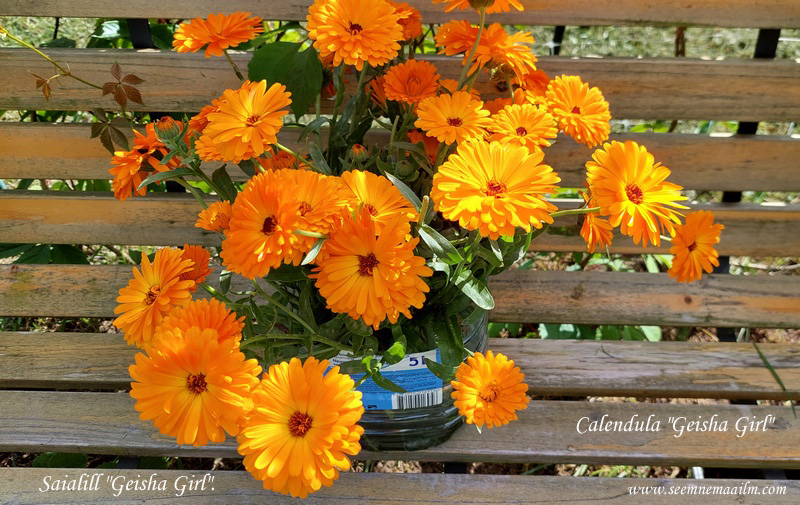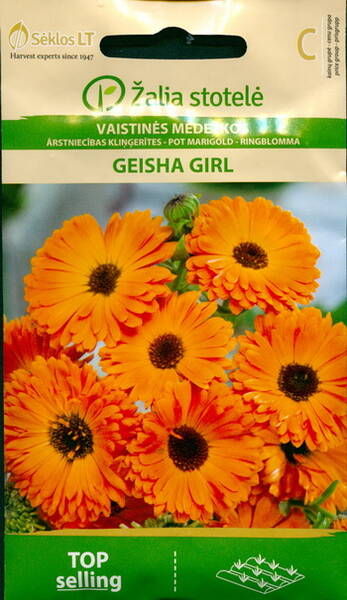A popular, unpretentious plant from the Asteraceae family. Blooms from June to September. Flowering is plentiful and long, especially when removing faded inflorescences.
Inflorescences are orange with red petal tips. Plant height up to 50 cm.
Calendula is photophilous and prefers light soils, cold-resistant (can withstand up to -5°C).
Propagated by direct sowing in the ground. Seeds are sown in spring or before winter, seedlings appear after 7-10 days, after a while they are thinned out at a distance of 20 cm.
Blooms 50-60 days after sowing. It is used for registration of a site and obtaining a cut.
1,0 g = 100-130 seeds.

* It is not very difficult to grow calendula in a garden plot, since this plant is unpretentious, tolerates short-term spring frosts well, is resistant to many diseases and pests, and also retains its decorative properties for a long time.
Location: a sunny place should be chosen for planting. Sowing calendula between beds of garden and vegetable crops allows for rational use of the land plot, and also helps in the fight against butterflies and ticks. Neighborhood with calendula can save asters from "black leg", and gladioli from thrips. But it is necessary to keep in mind the allelopathic features of plants: calendula roots secrete substances into the soil that, when planted close together, can delay the growth of, for example, radishes and basil.
Soil: it achieves its greatest decorative properties on fertile, sufficiently moist, well-drained soils. In autumn, when digging, it is advisable to add to the soil at the rate of 1 m2: 3-4 kg of humus, 15-20 g of phosphorus (superphosphate) and 20-30 g of potassium (potassium nitrate) fertilizers. Nitrogen (urea) - 30-35 g / m2 - it is better to add immediately before planting, since some forms of nitrogen are washed out by melt water.
Care: during long periods of dry and hot weather, water. On very poor soils, plants are fed every 4 weeks with a solution of complete mineral fertilizer. If you want to extend abundant flowering until late autumn, then you can immediately (as soon as the marginal flowers take a horizontal position) begin to collect inflorescences-baskets. The more you collect, the more will bloom again. If you do not do this at all, then flowering will only last until the end of July, and with partial collection it can continue for quite a long time, but not very abundantly.
Diseases and pests: affected by black spot (fungal disease). In this case, brown or black spots form on the leaves. For prevention, avoid applying excessive amounts of fertilizers, do not thicken the plantings. Remove affected plants immediately. Possible damage by true and false powdery mildew, aphids.
Reproduction: by seeds.
Calendula seeds are sown to a depth of 2-3 cm in early spring, but only after the onset of "physical maturity" of the soil, which can be determined in an old, reliable way: you need to squeeze a lump of soil in your fist, lift it to waist level and release. If the lump disintegrates, it means the soil has dried out enough and can be processed.
The sowing pattern depends on its purpose. To obtain individual spectacular plants, they are planted 30 x 30 cm or 40 x 40 cm.
If dense flower beds are needed, say, to decorate a path, or you want to collect as many medicinal inflorescences as possible from a small area, then the plants are planted 7-10 cm apart in a row and with a distance of 30-50 cm between rows. Shoots appear after 1-2 weeks. They bloom in ten weeks.
When growing seedlings, sowing is carried out in April in greenhouses. Seedlings are planted in flower beds in May. They can be sown before winter.
Calendula are very easy to propagate by self-seeding.
Use: for groups, flower beds, borders and cutting, medicinal gardens. Low-growing varieties are good in balcony boxes.
Partners: combine with species that contrast in flower color (blue ageratum, sage, delphinium), with flowering yellow and red flowers (rudbeckia, zinnia). For example, marigolds, eschscholzia and nasturtium will protect ornamental cabbage from cabbage flies and voracious caterpillars.

Calendula, Pot marigold, garden marigold, marygold.












